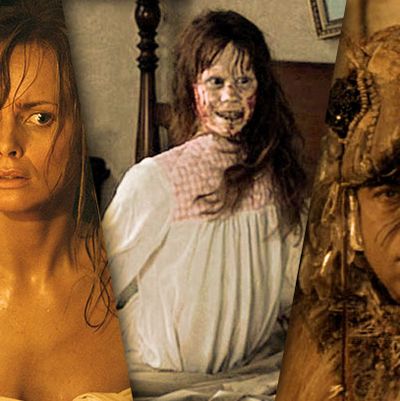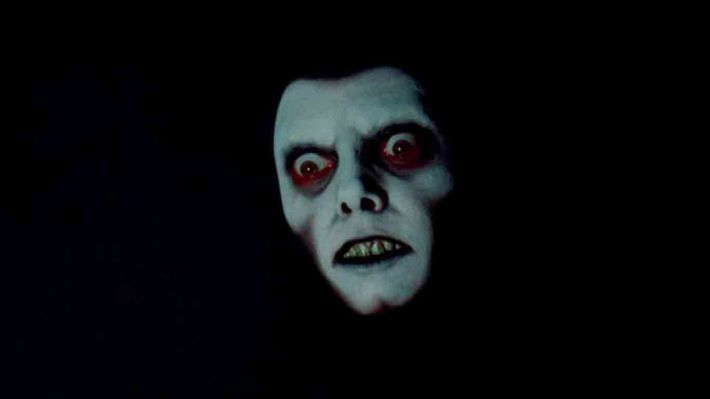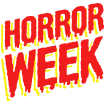
This piece was originally published October 31, 2013. We are republishing it as part of our Horror Week festivities.
The Exorcist is a classic. Not a horror classic, just a straight-up classic. And as a result, everyone knows the same pieces of trivia about its production (director William Friedkin would sometimes shoot off blanks on set to keep everyone on edge, he violently slapped one priest-actor in order to get a more emotionally raw performance, Regan’s vomit was made of pea soup and oatmeal) and reception. But there are so many more wonderful anecdotes about that film and its four sequels (or rather, two sequels and two prequels) to be had. We combed several director commentaries, making-of documentaries, and read several autobiographies to find the following tidbits. So read on. The power of Christ something something …
1. No one involved in any of the movies wanted to make a horror flick.
- Exorcist director William Friedkin: “I know that it is considered by a great many people as a horror film. I’ve never thought of it that way and I didn’t approach it that way. It’s a story about the mystery of faith.”
- Exorcist star Linda Blair: “Anybody who thinks this is a horror film is wrong.”
- Exorcist author and screenwriter William Peter Blatty: “I saw it as a supernatural detective story.”
- Exorcist II: The Heretic director John Boorman: “The idea of making a metaphysical thriller was terribly seductive to my psyche.”
- The Exorcist III director William Peter Blatty: “It was always meant to be a psychological thriller, not a special-effects horror film.”
- Dominion: Prequel to The Exorcist director Paul Schrader: “I had a different film in mind, more one about Merrin’s journey than strictly a horror vehicle.”
No one except for Exorcist: The Beginning director Renny Harlin, that is, who didn’t really seem to give a crap what he was doing.
The Exorcist
2. The sound made by Regan’s neck during the film’s famous head-spinning scene had an unlikely source. According to Friedkin in his autobiography, The Friedkin Connection, “At one point, [sound effects man Gonzalo Gavira] borrowed an old cracked leather wallet which contained some credit cards, and he held it up to the microphone and twisted it. And that sound was used in the movie to create the sound of the little girl’s head turning around.”
3. The iconic (an overused word, but appropriate in this case) image of Father Merrin standing outside the MacNeil house illuminated in a beam of light was inspired by Magritte’s The Empire of Light II.
4. The film’s prologue, set in Iraq, was actually shot there in 1972/3. The U.S. had no diplomatic relations with the country, and so Friedkin had to take a British crew to work on scenes with actor Max von Sydow. The Iraqi government agreed to the shoot under three circumstances: (1) Friedkin & Co. had to train local Iraqis in film techniques, (2) they had to teach local Iraqis how to make movie blood, and (3) Friedkin had to donate a print of his Oscar-winning film The French Connection.
5. In January 2004, the Telegraph reported that U.S. troops near Mosul in northern Iraq (where Friedkin filmed) were preparing to launch Exorcist tours to try to help the local economy. The plan was scuttled when Al Qaeda militants flooded the area.
6. The white demon face that we first see in Father Karras’s dream sequence (which Friedkin says was influenced by Alain Resnais’s use of subliminal editing in his Holocaust documentary Night & Fog) was never meant to be used in the film. It was an outtake from makeup tests performed on Eileen Dietz, Linda Blair’s body double. Friedkin had a last-minute inspiration to include just a few frames in the dream sequence and then later again during the exorcism itself.

7. Many of the women who appeared in the scene where Father Karras visits his mother in Bellevue were actually mental patients. Friedkin filmed part of the scene with hidden cameras.
8. The gentleman on the New York subway platform who asks Father Karras to spare some change was a drunk who was cast after being found in a 14th Street bar. Months later, they had to hunt him down to rerecord his line of dialogue. According to Friedkin, “He had no memory of filming the scene. When he saw his face on the screen, appearing again and again in a loop, he thought he was in an alternate universe.”
9. Directors who were approached before Friedkin included Stanley Kubrick, Bonnie and Clyde’s Arthur Penn, and The Graduate’s Mike Nichols, who turned down the job because he thought, “You’ll never find a 12-year-old girl to carry the picture.”
10. Before deciding to not have any music in the film (aside from the famous “Tubular Bells” theme that was the first giant hit for Richard Branson’s Virgin Records), Friedkin rejected two famous composers. The first was Hitchcock collaborator Bernard Herrmann (Vertigo, Psycho, North by Northwest), who wanted to record a using a giant church organ and didn’t want Friedkin to have any involvement. The second was Mission: Impossible’s Lalo Schifrin, who actually did gather an orchestra and record a dissonant score that Friedkin hated, though it was used in an early, infamous trailer for the film.
11. The sound design in The Exorcist is really an essential part of the film, equally important to the special effects and the performances, so one more sound tidbit is necessary. Friedkin writes, “During a recording session, [music producer Jack Nitzsche’s] girlfriend was sleeping facedown on a couch. He placed a microphone on the floor next to her and ran across the studio and jumped on her back, landing with both knees. Her shocked reaction is the sound we used when Regan throws up on Father Karras.”
12. Blatty was troubled by the fact that many viewers, according to him, were misled into believing that the demon forced Father Karras to throw himself out of the window at film’s end, as opposed to Karras willingly choosing to kill himself rather than harm Regan. He blames the confusion on bad editing and choreography in those final moments.
The Exorcist II: The Heretic
13. The movie is considered one of the worst sequels (nay, one of the worst anythings) of all time. But it had its partisans, including film critic Pauline Kael, who preferred it over the original, and Martin Scorsese, who once noted it as one of his guilty pleasures of that year.
14. Director John Boorman (Deliverance, Zardoz), set out to make a film that would be the exact opposite of the first film. And that was a mistake. “Millions of people had enjoyed watching a child being tortured in The Exorcist,” wrote Boorman in his autobiography Adventures of a Suburban Boy. “The Heretic would be the antidote, a film about goodness rather than evil. I should have known better. Kubrick told me that the only was to do a sequel to The Exorcistis to give them even more gore and horror than before. No one is interested in goodness.” Years after releasing the film, Boorman reflected on it, saying, “The sin I committed was not giving the audience what it wanted in terms of horror … There’s this wild beast out there which is the audience. I created this arena and I just didn’t throw enough Christians into it.”
15. In fact, the response to the movie was so negative that Boorman reedited the last part of the film (which itself was heavily rewritten doing shooting) in an attempt to improve reception as it rolled out in more and more theaters. He failed.
16. The final product strayed far from the initial concept. “The Heretic was first envisioned as a very inexpensive effort,” said producer Dick Lederer in Barbara Pallenberg’s book The Making of Exorcist II: The Heretic. “What we essentially wanted to do with this sequel was to redo the first movie — have the central figure, an investigative priest, interview everyone involved in the exorcisms, then fade out to unused footage, unused angles from the first movie. A low-budget rehash — about $3 million — of The Exorcist. A rather cynical approach to moviemaking, I’ll admit, but that was the start.”
17. Eventually the movie became a story involving the theories of the French Jesuit priest Pierre Teilhard de Chardin, a machine called “the synchronizer” that allowed two minds to experience the same memories, a sexy demon Linda Blair, and James Earl Jones dressed up in a giant locust costume.
18. Filming on the movie had to stop for more than a month after Boorman came down with San Joaquin Valley Fever.
19. Richard Burton, who played lead role Father Lamont, only did the movie for money, which is totally fine. In Pallenberg’s book, he says, “To be perfectly frank, I did this picture because, although I already had the film of Equus, and they didn’t want me to do another one in between, I needed the ready cash for my divorce, which I knew would come up soon.”
20. After the city of Washington, D.C., refused to let the production film at what had by then become known as the “Exorcist Steps” and after negotiations with the owner of the Georgetown house fell apart, Boorman & Co. decided to build the house and the street on a backlot, which resulted in a climax that looked fake as hell.
The Exorcist III
21. William Peter Blatty, who wrote the novel on which the original film was based and won an Academy Award for his screenplay on The Exorcist, directed this film based on his novel Legion, which picked up with the character of Detective Kinderman (played by Lee J. Cobb in the original and here by George C. Scott) investigating a series of murders that bear the imprint of a long-dead serial killer.
22. Blatty filmed a tight psychological thriller and executives hated it, especially because it had no exorcism of any kind. “They had come for slashings, for blood and guts,” said Blatty. “Obviously I never wanted the film to be characterized in that way, and that is one of the reasons why I personally resisted using the title The Exorcist III. I wanted the movie to be called Legion but the producers disagreed.” Jason Miller, who played Father Karras in the original (a character who died, by the way), was brought in and a special-effects heavy exorcism was tacked onto the film’s end.
23. Despite the movie being destroyed by producers, the current cut of Exorcist III still does contain one of the great jump scares of modern horror cinema. It’s best watched within the context of the entire film, but it’s here if you want it.
24. Serial killer Jeffrey Dahmer became obsessed with The Exorcist III, focusing on the serial-killer character portrayed by Brad Dourif (the voice of Child Play’s Chucky), as well as the Emperor in Return of the Jedi. “He did identify with the power of these characters,” testified forensic psychiatrist Park Dietz at Dahmer’s trial. “The characters are unattractive ones … but he liked the idea of the power they had and it happens that both those characters are portrayed with yellow eyes … and Mr. Dahmer went to the extent of buying contact lenses with a yellow tint … He wanted to be more like those people … Sometimes he would bring the victim home and watch a portion of the film with them.”
Dominion: Prequel to the Exorcist
25. This was director Paul Schrader’s first major movie in two decades. He came onto the project following the death of director John Frankenheimer in July 2002. Liam Neeson was initially supposed to star as a young Father Merrin, but fled after Frankenheimer’s demise. Stellan Skarsgård came on to play the role originated by fellow Swede Max von Sydow.
26. The film shot at Rome’s famous movie studio Cinecittà. And as Schrader notes, “Across the studio street from where we were, Mel Gibson was shooting Passion of the Christ — Christ and the Devil across the way [from each other].”
27. As with The Exorcist III, executives were very displeased with the slow, philosophical tone of Schrader’s film. They also wanted more exorcism!!! So Schrader was kicked off the film production and a new director was brought in to film an entirely new movie with an entirely new cast, save for Skarsgård.
Exorcist: The Prequel
28. Renny Harlin was brought in as the new director on a rushed production. After two weeks of filming, Harlin was hit by a car on a Rome street and had to direct the rest of the movie while on crutches.
29. Skarsgård “changed my makeup so that they couldn’t use anything from the first film for the second film.”
30. Harlin & Co. were working on special effects shots up to two weeks before release, which might account for the movie’s atrocious (and immediately mocked) CGI hyenas.


